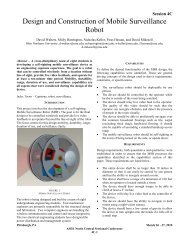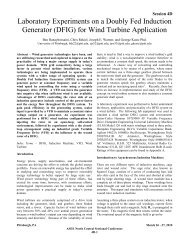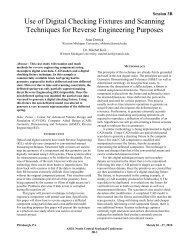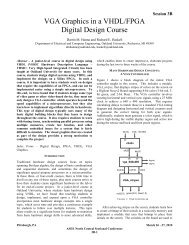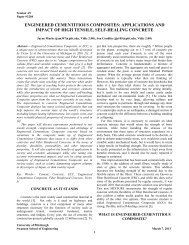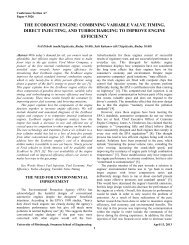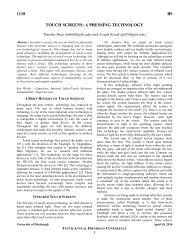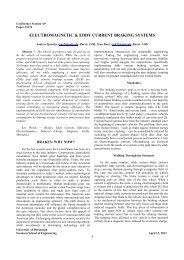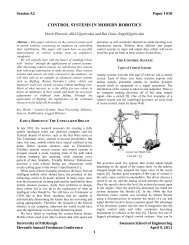THE OTTO CYCLE: FROM CHEMICAL TO MECHANICAL ENERGY
THE OTTO CYCLE: FROM CHEMICAL TO MECHANICAL ENERGY
THE OTTO CYCLE: FROM CHEMICAL TO MECHANICAL ENERGY
Create successful ePaper yourself
Turn your PDF publications into a flip-book with our unique Google optimized e-Paper software.
Session C7<br />
Paper 3176<br />
<strong>THE</strong> <strong>OT<strong>TO</strong></strong> <strong>CYCLE</strong>: <strong>FROM</strong> <strong>CHEMICAL</strong> <strong>TO</strong> <strong>MECHANICAL</strong> <strong>ENERGY</strong><br />
Colin L. Detweiler (cld77@pitt.edu, Bursic 2 PM), Hal T. Hamilton Jr. (hth5@pitt.edu, Bursic 2 PM)<br />
Abstract—The transfer of energy from the chemical<br />
potential energy of covalent bonds to mechanical movement<br />
has been utilized for centuries, whether that movement has<br />
been to pump water out of a coal mine, turn the crankshaft<br />
of an automobile, or rotate a generator's dynamo. This<br />
paper will describe one method of performing that transfer:<br />
the Otto cycle.<br />
Heat engines, such as an automobile's engine or a<br />
generator's turbine, use thermodynamic cycles to extract<br />
mechanical energy from changes in the pressure and volume<br />
of a “working fluid,” a liquid or gas that is enclosed in (or<br />
passes through) the engine. In the case of the Otto cycle, the<br />
pressure produced by the combustion of a mixture of air and<br />
vaporized hydrocarbons is exploited to exert force over<br />
distance—usually, on a piston through a cylinder—and<br />
transform those hydrocarbons' chemical potential energy<br />
(made into available heat and pressure by the combustion)<br />
into the mechanical (kinetic) energy of a spinning crankshaft.<br />
This paper will describe the four-stroke Otto cycle (and<br />
its widespread variants, the Diesel and two-stroke cycles),<br />
and detail how the Otto cycle may be improved with further<br />
technological advancements, in order to increase efficiency<br />
and mitigate deleterious effects on the environment.<br />
Key Words—Brayton Cycle, Diesel Cycle, Gasoline, Heat<br />
Engine, Otto Cycle, Rankine Cycle<br />
<strong>THE</strong> IMPORTANCE OF <strong>THE</strong> <strong>OT<strong>TO</strong></strong> <strong>CYCLE</strong><br />
Many processes useful to human civilization—pumping,<br />
weaving, transportation—require mechanical energy. The<br />
most obvious way to obtain and use mechanical energy is to<br />
get it directly from moving objects; for example, a water<br />
wheel steals mechanical energy from a river, and a windmill<br />
exploits the motion of the air to turn a shaft. However, such<br />
mechanical-to-mechanical transfers are limited to certain<br />
locations (near a river, in a windy area) and can vary widely<br />
in power output (spring thaw vs. winter freeze, hurricane vs.<br />
doldrums), and humans generally don't want important<br />
industrial processes to rely on the vagaries of the weather.<br />
A more useful source of power is chemical energy,<br />
released when certain substances bond with other<br />
substances—for example, when wood burns in oxygen, the<br />
reaction releases energy in the form of heat, and when<br />
hydrogen burns in oxygen, a blast of high-pressure gases (an<br />
explosion) is created. However, a major problem is how to<br />
convert that heat and pressure into useful mechanical energy,<br />
as well as preventing it from becoming dangerous.<br />
Thermodynamic cycles are methods of doing exactly that,<br />
using metal and moving parts. Before the invention of the<br />
Otto cycle in the late nineteenth century, the predominant<br />
method for the conversion of chemical into mechanical<br />
energy was the reciprocating steam engine, which relied on<br />
externally-combusted coal fuel and a heavy water boiler;<br />
though it was useful, it was inefficient and difficult to move.<br />
The Otto engine was the first useful internal-combustion<br />
engine, allowing the use of gaseous and liquid fuels, such as<br />
coal gas and gasoline, in a more compact and portable form.<br />
Since its invention, it's been a major thermodynamic cycle,<br />
and more liquid fuels (gasoline, Diesel fuel, etc.) have been<br />
used than gaseous (natural gas) and solid (coal, wood, etc.)<br />
fuels [1].<br />
EXPLANATION OF <strong>THE</strong> <strong>CYCLE</strong><br />
Basic Process<br />
An Otto engine is typically made up of several cylinders,<br />
in each of which a separate Otto cycle takes place, out of<br />
phase with the others so that power output is evenly spaced<br />
over time—for example, in a V8 engine with eight cylinders,<br />
one might go through the power stroke every eighth of a<br />
second. In each cylinder, a piston moves up and down, and<br />
converts its back-and-forth movement to the rotation of a<br />
crankshaft (a long rod, which spins in a hollow crankcase<br />
below the cylinder); the piston uses lubricating oil to form a<br />
tight seal against the cylinder wall. Each cylinder has two<br />
openings at the top: an intake valve, for the incoming fuelair<br />
mixture; and an exhaust valve, for outgoing exhaust<br />
gases. In addition, a spark plug at the top of the cylinder is<br />
used to create sparks for ignition. The lubricating oil, stored<br />
in the crankcase, is pumped into the rods connecting the<br />
piston to the crankshaft, is sprayed into the engine from<br />
small holes in those parts, and then drips back down into the<br />
crankcase, where it's filtered and recycled [2].<br />
The original form of the Otto cycle, and the one most<br />
widely used in developed countries, is the four-stroke cycle,<br />
so named because the piston goes through four strokes<br />
(movements in different directions) over each repetition of<br />
the cycle. First, in the intake stroke, the piston moves down,<br />
decreasing the pressure in the cylinder and drawing air<br />
through the opened intake valve, where fuel is sprayed and<br />
mixed into the air. Second, in the compression stroke, the<br />
intake valve closes and the piston moves up, compressing<br />
the air at the top of the cylinder; when the cylinder reaches<br />
the top and the air is at maximum compression, a spark plug<br />
creates a spark to ignite the fuel-air mixture, which explodes<br />
and puts pressure on the piston. Third, in the power stroke,<br />
the increased pressure from the exploded fuel-air mixture<br />
forces the piston down, exerting force over distance to add<br />
University of Pittsburgh, Swanson School of Engineering 2 April 2013<br />
1
Colin L. Detweiler<br />
Hal T. Hamilton Jr.<br />
mechanical energy to the piston (and, thereby, the<br />
crankshaft). Fourth, in the exhaust stroke, the piston rises,<br />
forcing the burned exhaust gases out through the exhaust<br />
valve, which closes behind them [2].<br />
FIGURE 1<br />
crankcase. Second, in the power/exhaust stroke, the<br />
explosion of the mixture in the cylinder forces the piston<br />
down, which uncovers the intake port (a simple hole, rather<br />
than a valve, which connects the cylinder with the crankcase)<br />
and the exhaust port (which connects the cylinder with the<br />
outside air) and allows the mixture in the crankcase (which<br />
is being compressed by the downward-moving piston) to<br />
move upwards through the intake port and force the exhaust<br />
gases out through the exhaust port [2].<br />
FIGURE 2<br />
A schematic drawing of the four-stroke cycle [3]. Blue<br />
indicates fuel-air mixture, red indicates exhaust gases.<br />
The fuel for an Otto engine is typically gasoline, a<br />
mixture of light, liquid hydrocarbons—ideally octane (as the<br />
“octane rating” on commercially-sold gasoline suggests), but<br />
usually including such other impurities as heptane and<br />
pentane, which can cause premature explosions in the<br />
cylinder, which lower efficiency and reliability [4].<br />
Major Variants<br />
The two-stroke engine, developed a few decades after the<br />
four-stroke, performs two strokes at once in different places.<br />
First, in the intake/compression stroke, the piston moves up,<br />
compressing a mixture of air, fuel, and lubricating oil in the<br />
cylinder and simultaneously drawing a new mixture into the<br />
A schematic drawing of the two-stroke cycle [5]. Pink<br />
indicates fuel-air mixture, peach indicates exhaust gases.<br />
The Diesel engine, invented by Rudolf Diesel, still uses<br />
the four strokes of the standard Otto engine, but takes only<br />
air in through the intake valve, and injects the fuel directly<br />
into the cylinder at the end of the compression stroke. The<br />
compression stroke produces a higher pressure than in the<br />
four-stroke engine, igniting the fuel without the need for a<br />
spark plug (or the concomitant electrical wiring, improving<br />
reliability) [2]. Since the light hydrocarbons in gasoline<br />
ignite prematurely in the high-pressure environment of the<br />
Diesel engine, Diesel fuel is made up of longer, heavier<br />
hydrocarbons, such as cetane [6], which is twice as large as<br />
octane.<br />
IMPORTANCE OF <strong>THE</strong> <strong>CYCLE</strong><br />
University of Pittsburgh, Swanson School of Engineering 2 April 2013<br />
2
Colin L. Detweiler<br />
Hal T. Hamilton Jr.<br />
Areas of Use<br />
In 2011, fifty-seven billion gallons of Diesel fuel and 14<br />
billion gallons of gasoline were sold in the United States<br />
alone [7], and in 2009, four hundred billion gallons of Diesel<br />
fuel and three hundred billion gallons of gasoline were used<br />
worldwide [8]. Most automobiles use some form of the Otto<br />
cycle, whether it’s the four-stroke, the two-stroke, or the<br />
Diesel cycle; in addition, the Diesel engine is used in<br />
industry and to power ships [11], and the two-stroke is often<br />
used in such smaller applications as snowmobiles, ATVs,<br />
and small boats [12]. It’s estimated that more than a quarter<br />
of all greenhouse-gas emissions in the United States<br />
originate from automobiles [13].<br />
Advantages over the Competition<br />
Other widely-used thermodynamic cycles include the<br />
Rankine cycle and the Brayton cycle. The Rankine cycle,<br />
once used in the reciprocating steam engines of locomotives,<br />
is used in the steam turbines of electricity-generation plants:<br />
water is boiled by the heat of externally burned fuel (usually<br />
coal, oil, or natural gas), becomes high-pressure steam, and<br />
forces its way through a turbine, which turns the crankshaft<br />
that runs the electrical generator; the water then cools,<br />
condenses, and is recycled [9]. Since the fuel is burned<br />
outside of the engine, however, the separate combustion<br />
chamber takes up more space than an internal-combustion<br />
engine of equal power. In addition, since the fuel must be<br />
burned at a minimum temperature to make the water boil at<br />
all, the engine's efficiency is low at low power output [1].<br />
In the Brayton cycle, used in gas-turbine engines in jet<br />
airplanes and large ships, compressed air is taken in through<br />
a large intake in the front of the engine, funneled through a<br />
compressor to increase its pressure, and forced into a<br />
combustion chamber where fuel is mixed with it and ignited.<br />
The exhaust gases, now at even higher pressure and<br />
temperature, drive a turbine at the rear of the engine (which<br />
in turn drives a crankshaft) before exiting at lowered<br />
pressure and temperature [9]. However, the high<br />
temperatures and pressures that are necessary for efficient<br />
combustion produce more power than can be used for such<br />
small-scale purposes as automobiles [10].<br />
ETHICAL PROBLEMS<br />
Problems with the Cycle<br />
In two-stroke engines, since the crankcase is used in the<br />
intake/power stroke, it can't be used to store lubricating oil,<br />
so the lubricating oil is vaporized and mixed into the intake<br />
air with the fuel. However, this causes the lubricating oil to<br />
be burned with the fuel in the intake/power stroke; this<br />
increases harmful emissions, including carbon monoxide and<br />
soot (unburned fuel) [14]. Carbon monoxide directly impairs<br />
humans’ absorption of oxygen [15], while both carbon<br />
monoxide and soot contribute to smog formation [16]. This<br />
is a major problem in large cities in undeveloped countries,<br />
such as in China and India, where many vehicles use twostroke<br />
engines, which tend to be cheaper and simpler to<br />
maintain than four-strokes. In addition, many motorcycles in<br />
such places have sidecars attached, whose added weight<br />
forces their engines above their intended power output,<br />
further reducing efficiency and increasing emissions. The<br />
World Health Organization ranks outdoor air pollution<br />
thirteenth in worldwide death contributors. In Calcutta and<br />
Delhi in India, two-thirds of residents suffer from chronic<br />
colds and coughs because of the effects of air pollution,<br />
which lead to asthma and lung cancer [17].<br />
Engines based on the Otto cycle also have effects on the<br />
environment in general. In the United States, due to the<br />
increasing use of automobiles, both air pollution and acid<br />
rain have increased [18]. As a side effect of the high<br />
temperatures of combustion in Otto engines, the nitrogen<br />
that composes the majority of the air combines with oxygen<br />
to form various oxides of nitrogen, primarily nitric oxide<br />
[14]. After rising into the atmosphere, nitric oxide reacts<br />
with water vapor to form corrosive nitric acid, which<br />
dissolves into rainwater. Due to these mixtures' acidic pH,<br />
the rain that accumulates from these clouds affects the<br />
environment in many different ways, from eroding buildings<br />
and damaging cars to deleteriously affecting the<br />
concentrations of elements in soil and waterways [18].<br />
Problems with the Fuel<br />
Through the refining process of gasoline, toxic artificial<br />
compounds are added such as methyl tert-butyl ether are<br />
added [19]. Methyl tertiary-butyl ether, or MTBE for short,<br />
is used to raise the oxygen content of gasoline to make<br />
engines run more smoothly and burn fuel more completely,<br />
increasing efficiency and reducing emissions [19]. However,<br />
studies done by the U.S. Environmental Protection Agency<br />
show that animals who inhaled high concentrations of<br />
MTBE “developed cancers or experienced other noncancerous<br />
health effects” [19]. In addition, MTBE is very<br />
soluble in water and has the potential to contaminate<br />
drinking water, though its carcinogenicity when drunk has<br />
not been thoroughly researched [19].<br />
Another prominent additive is tetraethyl lead. Invented in<br />
the early twentieth century to increase the smoothness and<br />
efficiency of Otto engines, it was banned in most developed<br />
countries after it was determined that the exhaust gases of<br />
engines that used it contained high levels of lead, and tended<br />
to afflict large amounts of people in factories and urban<br />
areas with lead poisoning [21]; however, as of 2011, two<br />
hundred million people lived in undeveloped countries<br />
where tetraethyl lead was still used [22] as a cheap<br />
alternative to expensive catalytic converters [23].<br />
In addition to artificial additives, the natural components<br />
of gasoline can also be detrimental to human health. Toxic<br />
University of Pittsburgh, Swanson School of Engineering 2 April 2013<br />
3
Colin L. Detweiler<br />
Hal T. Hamilton Jr.<br />
components of unadulterated gasoline include carcinogenic<br />
“aromatic” hydrocarbons, most notably benzene [20]. In<br />
addition, petroleum naturally contains sulfur, which is<br />
combusted into sulfur dioxide. Sulfur dioxide is as damaging<br />
as nitric oxide (described above) in the creation of acid rain,<br />
and is also directly toxic to humans [24].<br />
In a more long-term fashion, though, one of the more<br />
dangerous emissions of burned hydrocarbons is carbon<br />
dioxide. While not directly or indirectly toxic, it contributes<br />
to global climate change by preventing infrared radiation<br />
from escaping from Earth’s surface to interplanetary space<br />
[25].<br />
Petroleum and Sustainability<br />
Much of the petroleum that remains to be extracted from<br />
the Earth is located in chronically undeveloped and unstable<br />
places, such as Iran, Iraq, Libya, Nigeria, and Saudi Arabia<br />
[26]. Since gasoline and Diesel fuel are refined from<br />
petroleum, and these countries control a large proportion of<br />
the petroleum supply, disruptions in that supply caused by<br />
natural disasters, diplomatic impasses, or military action (by<br />
states or by non-state entities) can cause extreme<br />
fluctuations in the prices of those fuels. An eminent example<br />
is, of course, the oil crisis of the 1970s, in which several oilproducing<br />
Arab countries, angered by the United States'<br />
support of their enemy Israel in the Yom Kippur War,<br />
lowered petroleum production and increased prices,<br />
quadrupling the price of oil and severely impacting<br />
economies worldwide [27]. This means that using<br />
petroleum to fuel Otto cycle engines is not very sustainable<br />
as this small number of countries could drastically curtail<br />
petroleum production and export at any time, leading to<br />
worldwide petroleum shortages. These shortages would<br />
become worse because the other areas where petroleum is<br />
produced would not be able to sustain the world’s demands.<br />
One way to decrease the world’s dependence on<br />
petroleum (which affects more of the world's economy than<br />
merely Otto engines, such as plastic production) is to modify<br />
the fuel intake of these machines. This is explained further in<br />
the next section, but overall, this would make a large impact<br />
on the sustainability of the Otto cycle. The world simply is<br />
not the same as it was when Nikolaus Otto invented the Otto<br />
cycle in the 1800s. The Earth’s natural resources are being<br />
depleted at exponential rates as third-world countries<br />
continue to develop and industrialize and the world’s<br />
population increases. In order to make the Otto cycle<br />
sustainable, alternative fuel sources such as biodiesel must<br />
be considered.<br />
Another, possibly less effective, method to decrease this<br />
vital dependence is by increasing the Otto cycle’s efficiency.<br />
There exists a variety of methods to do this, including<br />
adding air compressors to increase energy output from<br />
combustion, modifying the way fuel is introduced to the<br />
engine, and adding additional components to recover<br />
additional energy form the machine that the Otto cycle<br />
powers. These methods will be further explained in the next<br />
section.<br />
HOW IT CAN BE IMPROVED<br />
Minor Adjustments<br />
Various methods of improving the Otto cycle’s<br />
efficiency and emissions characteristics have been proposed<br />
and adopted. One of the most prevalent is the catalytic<br />
converter, which attaches to an engine’s exhaust system and<br />
converts nitric oxide, carbon monoxide, and soot into<br />
harmless water and nitrogen, and relatively harmless carbon<br />
dioxide [28]; however, it uses expensive metals (including<br />
platinum) to promote the necessary chemical reactions, and<br />
its use is therefore largely limited to developed countries<br />
[28].<br />
The supercharger, a fan placed before the intake valve,<br />
effectively steals a page from the Brayton cycle’s book of<br />
tricks by using part of the energy produced in the Otto<br />
engine’s power stroke to compress the air taken in in the<br />
intake stroke and force more of the fuel-air mixture into the<br />
cylinder, increasing power and efficiency; the<br />
turbosupercharger, or “turbocharger,” does the same, but<br />
takes the energy from the pressure of the escaping exhaust<br />
gases, which would otherwise be wasted [9].<br />
In direct injection, fuel is injected into an engine’s<br />
cylinder in several places, rather than solely at the top of the<br />
cylinder. This allows combustion to occur smoothly and<br />
evenly throughout the cylinder, rather than wherever the airfuel<br />
mixture happens to swirl after entering through the<br />
intake valve, and also increases efficiency [29].<br />
The addition of electric motors and batteries to an engine<br />
can improve efficiency and emissions by using the motors as<br />
generators to recoup wasted heat energy from the brakes,<br />
and by using electric motors rather than the Otto engine<br />
when possible [30]; however, if the original electricity was<br />
generated with coal or some other similarly-polluting fuel,<br />
there may be a net increase in emissions, rather than a<br />
decrease [31].<br />
Major Adjustments<br />
Fuel need not be refined from petroleum; several<br />
methods of obtaining fuel from other sources have been<br />
devised, though the engine must be extensively modified in<br />
order to have the correct temperature and compression ratio<br />
for the new fuel. Biodiesel, a mixture of oxygen-containing<br />
hydrocarbons derived from vegetable oil and animal fat,<br />
greatly reduces most unwanted emissions and aids in<br />
lubricating the engine, but tends to congeal at low<br />
temperatures [32]. Ethanol (the same alcohol that’s found in<br />
whiskey), derived from fermenting the sugar or cellulose in<br />
certain plants (most prominently, corn in the United States<br />
University of Pittsburgh, Swanson School of Engineering 2 April 2013<br />
4
Colin L. Detweiler<br />
Hal T. Hamilton Jr.<br />
and sugarcane in Brazil), is also a potential alternative fuel<br />
for standard Otto engines [33]; however, there are problems<br />
with finding enough arable land to grow enough plants to<br />
satisfy energy needs without raising food prices [34].<br />
A proposed “six-stroke engine” would use a secondary<br />
Rankine cycle to recover the otherwise wasted heat energy<br />
of the still-warm exhaust gases of an Otto or Diesel engine,<br />
by retaining some hot exhaust gases in the cylinder and<br />
injecting water into the cylinder, which expands to produce a<br />
second power stroke; however, difficulties include<br />
preventing the steam from condensing on the soot in the<br />
exhaust, which would damage the engine [35].<br />
<strong>THE</strong> FUTURE OF <strong>THE</strong> <strong>OT<strong>TO</strong></strong> <strong>CYCLE</strong><br />
The Otto cycle and its variants are well-suited for such<br />
small and medium-sized portable applications as<br />
automobiles and portable generators, and will continue to be<br />
used widely in the future. It's to be hoped that, by<br />
implementing some of the major and minor adjustments to<br />
the Otto cycle mentioned, the cycle can continue to grow in<br />
its number of applications and improve efficiency, which<br />
will ultimately improve the Otto cycle’s sustainability.<br />
While they do have some drawbacks in the areas of pollution<br />
and efficiency, those can be mitigated with such further<br />
technological advancements as the tacking-on of two<br />
additional strokes, or the use of fuels other than petroleumbased<br />
ones. By continuing to make these improvements,<br />
there are great hopes that the Otto cycle, although more than<br />
a century old, can have a competitive edge over the<br />
multitude of energy-transformation methods.<br />
REFERENCES<br />
[1] Committee on Motor Vehicle Emissions, Division of<br />
Engineering, National Research Council. Report by the<br />
Committee on Motor Vehicle Emissions. Washington, D.C.:<br />
National Academies Press, 1973. Web. 14 Feb. 2013.<br />
<br />
[2] CDX Online eTextbook. CDX Automotive, 2009. Web.<br />
25 Feb. 2013. <br />
[3] “The Four Stroke Cycle.” Picture. 4-Stroke Basics.<br />
Jordan INC., 2010. Web. <br />
[4] Ophardt, Charles E. “What Is Gasoline” Virtual<br />
Chembook. Elmhurst College, 2003. Web. 3 Mar. 2013<br />
<br />
[5] Beardmore, Roy. “Thermo 22 Two stroke.gif.” Picture.<br />
Thermodynamics Four Stroke Engines. N.p., 2013. Web.<br />
<br />
[6] “D613-10a Standard Test Method for Cetane Number of<br />
Diesel Fuel Oil.” ASTM Intl., 2010. Web. 3 Mar. 2013.<br />
<br />
[7] “Petroleum and Other Liquids.” U.S. Energy Information<br />
Administration. EIA.gov. Web. 26 Feb. 2013.<br />
<br />
[8] “2009 Energy Statistics Yearbook.” United Nations<br />
Statistics Division, 2010. United Nations. Web. 27 Feb.<br />
2013. <br />
[9] Powers, Joseph M. “Chapter 10: Cycles.”<br />
OpenCourseWare. U of Notre Dame, 4 May 2012. Web. 1<br />
Feb. 2013. <br />
[10] “Technology Characterization: Gas Turbines.”<br />
Environmental Protection Agency. Energy and<br />
Environmental Analysis, 2008. Web. 14 Feb. 2013.<br />
<br />
[11] Weston, Kenneth. Energy Conversion. U of Tulsa, 1992.<br />
Web. 1 Feb. 2013.<br />
<br />
[12] Williford, John. “Status and Prospects for Two-Stroke<br />
Engines Used in Off-Road Recreational Vehicles.” Chrysalis<br />
Technology Group, 30 Apr. 2001. Web. 1 Feb. 2013.<br />
<br />
[13] “Sources of Greenhouse Gas Emissions.” United States<br />
Environmental Protection Agency, 2012. Web. 7 Mar. 2013.<br />
<br />
[14] “Emissions #1 - Combustion Chemistry.” Toyota Motor<br />
Sales, U.S.A., n.d. Princeton U. Web. 15 Feb. 2013.<br />
.<br />
[15] “Carbon Monoxide.” Massachusetts Dept. of<br />
Environmental Protection, n.d. Web. 15 Feb. 2013.<br />
<br />
[16] “Smog and Health.” South Coast Air Management<br />
District, 2012. Web. 4 Mar. 2013.<br />
<br />
[17] Potera, Carol. “Air Pollution: Asia’s Two-Stroke<br />
Dilemma.” Environmental Health Perspective 112.11 (2004):<br />
A613. Web. 14 Feb. 2013.<br />
<br />
[18] Tennesen, Michael. “Sour Showers: Acid Rain Returns-<br />
-This Time It Is Caused by Nitrogen Emissions.” Nature<br />
American. ScientificAmerican.com. Web. 21 June 2010.<br />
<br />
[19] “Methyl Tertiary Butyl Ether (MTBE): Overview.”<br />
United States Environmental Protection Agency. 25 Jan.<br />
2013. Web. 15 Feb. 2013.<br />
<br />
University of Pittsburgh, Swanson School of Engineering 2 April 2013<br />
5
Colin L. Detweiler<br />
Hal T. Hamilton Jr.<br />
[20] “Benzene.” United States Environmental Protection<br />
Agency, 2012. EPA.gov. Web. 4 Mar. 2013.<br />
<br />
[21] “Special timeline: Leaded gasoline.” Environmental<br />
History Timeline, n.d. Web. 4 Mar. 2013.<br />
<br />
[22] Taylor, Robert, and Zac Gethin-Damon. “Countries<br />
where Leaded Petroleum is Possibly Still Sold for Road Use<br />
As at 17th June 2011.” The LEAD Group, 2011. Web.<br />
<br />
[23] “Octane Additives.” Innospec Inc., n.d. Web. 15 Feb.<br />
2013. <br />
[24] “Sulfur Dioxide.” Wisconsin Dept. of Health Services,<br />
2012. Web. 4 Mar. 2013.<br />
<br />
[25] “General Overview: The Greenhouse Effect.” U of<br />
California, San Diego, 2002. Web. 4 Mar. 2013.<br />
<br />
[26] “Country Comparison – Oil – Proved Reserves.” CIA<br />
World Factbook. Central Intelligence Agency, 2011. Web.<br />
<br />
[27] “1973-74 Oil Crisis.” Bancroft Library. Regents of the<br />
U of California, 2011. Web.<br />
<br />
[28] “The Catalytic Converter.” Worcester Polytechnic<br />
Institute, n.d. Web. 4 Mar. 2013.<br />
<br />
[29] Office of Transportation and Air Quality. “Engine<br />
Technologies.” U.S. Department of Energy, 1 Feb. 2013.<br />
Web. 1 Feb. 2013.<br />
<br />
[30] “How Hybrids Work.” United States Dept. of Energy,<br />
2013. Web. 6 Mar. 2013.<br />
<br />
[31] Office of Integrated Analysis and Forecasting. Light-<br />
Duty Diesel Vehicles: Market Issues and Potential Energy<br />
and Emissions Impacts. Energy Information Administration,<br />
2009. Web. 17 Jan. 2013.<br />
<br />
[32] “Biodiesel.” Alternative Fuels Data Center, 2013.<br />
United States Dept. of Energy. Web. 5 Mar. 2013.<br />
<br />
[33] “Ethanol.” Alternative Fuels Data Center, 2013. United<br />
States Dept. of Energy. Web. 5 Mar. 2013.<br />
<br />
[34] Albino, Dominic K., et al. “Food for Fuel: The Price of<br />
Ethanol.” New England Complex Systems Institute, 2012.<br />
Web. 5 Mar. 2013.<br />
<br />
[35] Conklin, James C., and James P. Szybist. “A highly<br />
efficient six-stroke internal combustion engine cycle with<br />
water injection for in-cylinder exhaust heat recovery.”<br />
Energy (2010): 1-7. Web.<br />
<br />
ACKNOWLEDGEMENTS<br />
The efforts of Nikolaus Otto, Rudolf Diesel, Joseph Day,<br />
and the other mechanical and chemical engineers who<br />
invented and refined the Otto engine and its variants are<br />
greatly appreciated.<br />
University of Pittsburgh, Swanson School of Engineering 2 April 2013<br />
6




